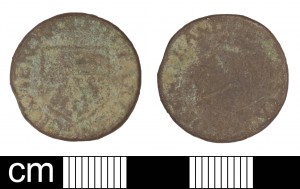
In the 17th century, small denominations of coinage were in short supply. This meant that day to day transactions, for instance buying a loaf of bread, became difficult. Following pilot schemes under Elizabeth I, copper farthings were issued officially under licence during the reigns of James I and Charles I. By the execution of Charles I in 1649, the shortage of small change was again severe (Dickinson, 1986, 4). It is at this point that unlicensed tokens began to be issued by private individuals.
Tokens were issued by local merchants and by local authorities, such as the constable of Taunton or the City of Wells. SOM-2DC917, a much worn token, is made of copper alloy. The legend reads ‘The farthing of a merchant// of the staple of England’ and depicts the arms of the Staple-Merchants on the obverse and a fleece on the reverse. The token is very unusual as it doesn’t give the location or name of the issuer.
The Staple managed the export of wool from the 1300’s and a merchant staple was the designated market for the wool trade in order to excise control over taxes and duties. By the 17th and 18th centuries, following export and import bans of raw wool and cloth, the Company of Merchants of the Staple of England was managing the wool supply within the UK, mainly confined to local markets.
This token provides a wonderful example of the role PAS can play in adding to the history of the country. Because this token, unlike most, doesn’t name the issuer or location and previous known examples are from historic collections rather than archaeological finds we don’t know where it was issued or by who. It could even have been an attempt to produce a generic type issued by several people in different locations which could be cashed in with any merchant of the staple. This token was found in Chedzoy, near Bridgwater and is the only example on the PAS database so far. Tokens do move through trade from their area of issue, but the find spots are usually confined to the surrounding counties. The find spot of this token, and similar ones found in future will help build the picture of where the token was issued and how widely it was traded.
For more information see Dickinson, M (1986) ‘Seventeenth Century Tokens of the British Isles and their Values’. Katie Marsden IfA/HLF Workplace Learning Bursary holder in Archaeological Finds in Somerset Laura Burnett Finds Liaison Officer for Somerset